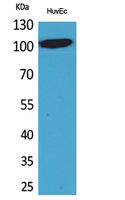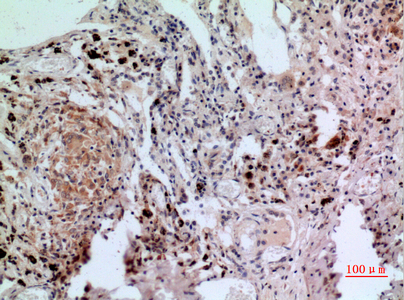产品名称
NFATc1 Rabbit Polyclonal Antibody
别名
NFATC1; NFAT2; NFATC; Nuclear factor of activated T-cells, cytoplasmic 1; NF-ATc1; NFATc1; NFAT transcription complex cytosolic component; NF-ATc; NFATc
蛋白名称
Nuclear factor of activated T-cells cytoplasmic 1
存储缓冲液
Liquid in PBS containing 50% glycerol, 0.5% BSA and 0.02% New type preservative N.
Human Gene Link
http://www.ncbi.nlm.nih.gov/sites/entrez?db=gene&term=4772
Human Swissprot No.
O95644
Human Swissprot Link
http://www.uniprot.org/uniprotkb/O95644/entry
Mouse Swissprot No.
O88942
Mouse Swissprot Link
http://www.uniprot.org/uniprot/O88942
免疫原
The antiserum was produced against synthesized peptide derived from the C-terminal region of human NFATC1. AA range:881-930
特异性
NFATc1 Polyclonal Antibody detects endogenous levels of NFATc1 protein.
稀释度
WB 1:500-2000;IHC-p 1:100-500;IF ICC 1:100-500;ELISA 1:5000-20000
宿主
Polyclonal, Rabbit,IgG
背景介绍
The product of this gene is a component of the nuclear factor of activated T cells DNA-binding transcription complex. This complex consists of at least two components: a preexisting cytosolic component that translocates to the nucleus upon T cell receptor (TCR) stimulation, and an inducible nuclear component. Proteins belonging to this family of transcription factors play a central role in inducible gene transcription during immune response. The product of this gene is an inducible nuclear component. It functions as a major molecular target for the immunosuppressive drugs such as cyclosporin A. Multiple alternatively spliced transcript variants encoding distinct isoforms have been identified for this gene. Different isoforms of this protein may regulate inducible expression of different cytokine genes. [provided by RefSeq, Jul 2013],
组织表达
Expressed in thymus, peripheral leukocytes as T-cells and spleen. Isoforms A are preferentially expressed in effector T-cells (thymus and peripheral leukocytes) whereas isoforms B and isoforms C are preferentially expressed in naive T-cells (spleen). Isoforms B are expressed in naive T-cells after first antigen exposure and isoforms A are expressed in effector T-cells after second antigen exposure. Isoforms IA are widely expressed but not detected in liver nor pancreas, neural expression is strongest in corpus callosum. Isoforms IB are expressed mostly in muscle, cerebellum, placenta and thymus, neural expression in fetal and adult brain, strongest in corpus callosum.
细胞定位
Cytoplasm . Nucleus . Cytoplasmic for the phosphorylated form and nuclear after activation that is controlled by calcineurin-mediated dephosphorylation. Rapid nuclear exit of NFATC is thought to be one mechanism by which cells distinguish between sustained and transient calcium signals. The subcellular localization of NFATC plays a key role in the regulation of gene transcription (PubMed:16511445). Nuclear translocation of NFATC1 is enhanced in the presence of TNFSF11. Nuclear translocation is decreased in the presence of FBN1 which can bind and sequester TNFSF11 (By similarity). .
信号通路
WNT;WNT-T CELLAxon guidance;VEGF;Natural killer cell mediated cytotoxicity;T_Cell_Receptor;B_Cell_Antigen;
功能
alternative products:Isoform C-alpha and isoform C-beta are the strongest activator of gene transcription, followed by isoform A-alpha and isoform A-beta, whereas isoform B-alpha and isoform B-beta are the weakest. Isoform B-alpha, isoform B-beta, isoform C-alpha and isoform C-beta, both present in T-cells, can modulate their transcriptional activity,domain:Isoforms C have a C-terminal part with an additional trans-activation domain, TAD-B, which acts as a transcriptional activator. Isoforms B have a shorter C-terminal part without complete TAD-B which acts as a transcriptional repressor.,domain:Rel Similarity Domain (RSD) allows DNA-binding and cooperative interactions with AP1 factors.,domain:The N-terminal transactivation domain (TAD-A) binds to and is activated by Cbp/p300. The dephosphorylated form contains two unmasked nuclear localization signals (NLS), which allow translocation of the protein to the nucleus.,function:Plays a role in the inducible expression of cytokine genes in T-cells, especially in the induction of the IL-2 or IL-4 gene transcription. Also controls gene expression in embryonic cardiac cells. Could regulate not only the activation and proliferation but also the differentiation and programmed death of T-lymphocytes as well as lymphoid and non-lymphoid cells.,induction:Only isoforms A are inducibly expressed in T lymphocytes upon activation of the T-cell receptor (TCR) complex. Induced after co-addition of phorbol 12-myristate 13-acetate (PMA) and ionomycin. Also induced after co-addition of 12-O-tetradecanoylphorbol-13-acetate (TPA) and ionomycin. Weakly induced with PMA, ionomycin and cyclosporin A.,PTM:Phosphorylated by NFATC-kinase; dephosphorylated by calcineurin.,similarity:Contains 1 RHD (Rel-like) domain.,subcellular location:Cytoplasmic for the phosphorylated form and nuclear after activation that is controlled by calcineurin-mediated dephosphorylation. Rapid nuclear exit of NFATC is thought to be one mechanism by which cells distinguish between sustained and transient calcium signals. The subcellular localization of NFATC plays a key role in the regulation of gene transcription.,subunit:Member of the multicomponent NFATC transcription complex that consists of at least two components, a pre-existing cytoplasmic component NFATC2 and an inducible nuclear component NFATC1. Other members such as NFATC4, NFATC3 or members of the activating protein-1 family, MAF, GATA4 and Cbp/p300 can also bind the complex. NFATC proteins bind to DNA as monomers.,tissue specificity:Expressed in thymus, peripheral leukocytes as T-cells and spleen. Isoforms A are preferentially expressed in effector T-cells (thymus and peripheral leukocytes) whereas isoforms B and isoforms C are preferentially expressed in naive T-cells (spleen). Isoforms B are expressed in naive T-cells after first antigen exposure and isoforms A are expressed in effector T-cells after second antigen exposure.,
纯化
The antibody was affinity-purified from rabbit antiserum by affinity-chromatography using epitope-specific immunogen.



